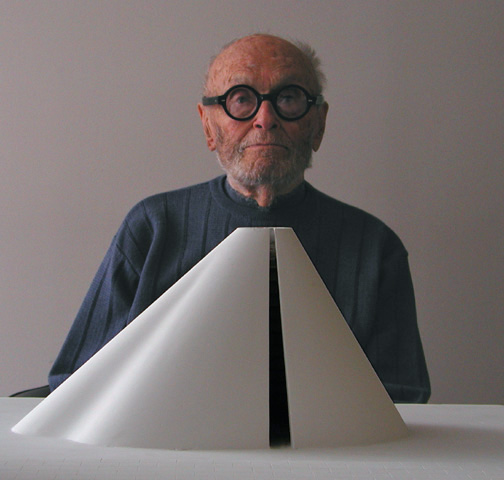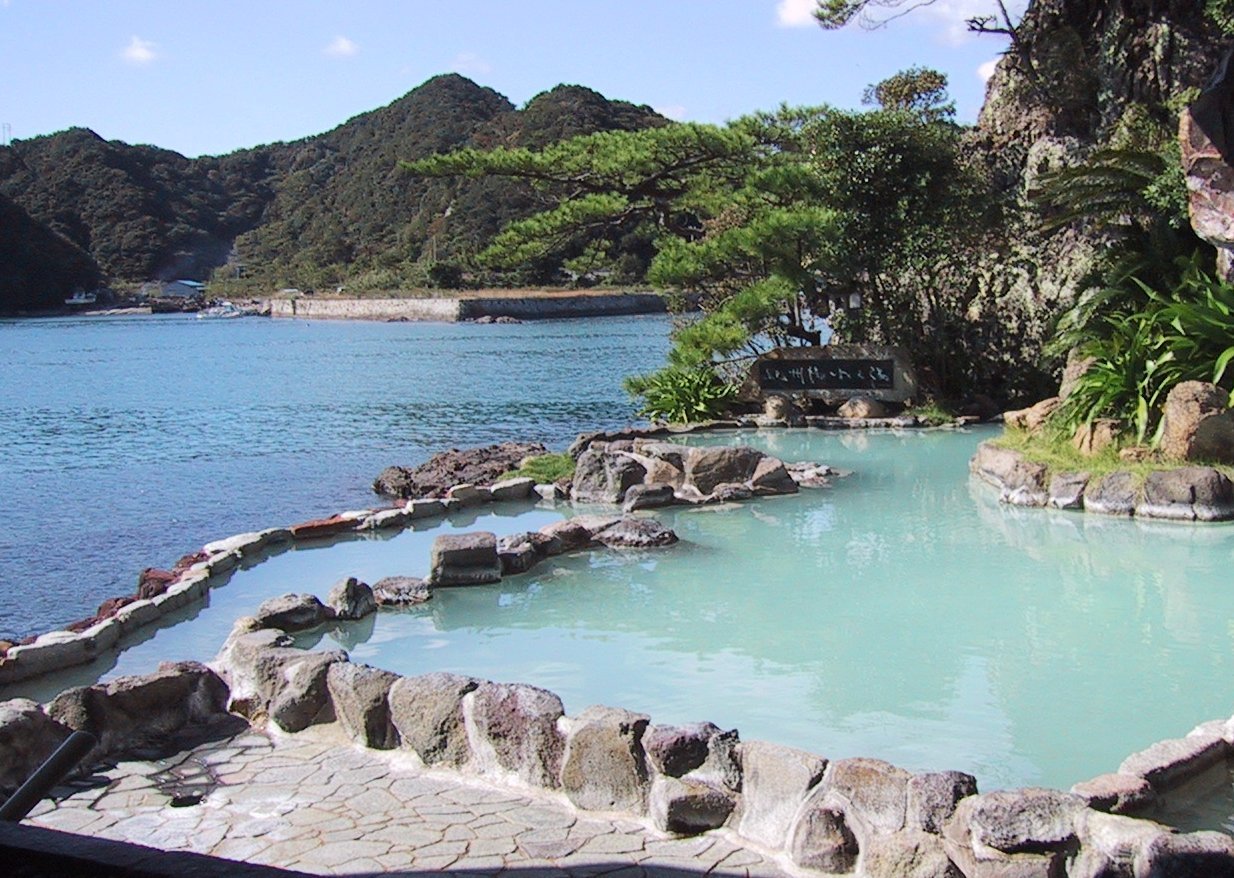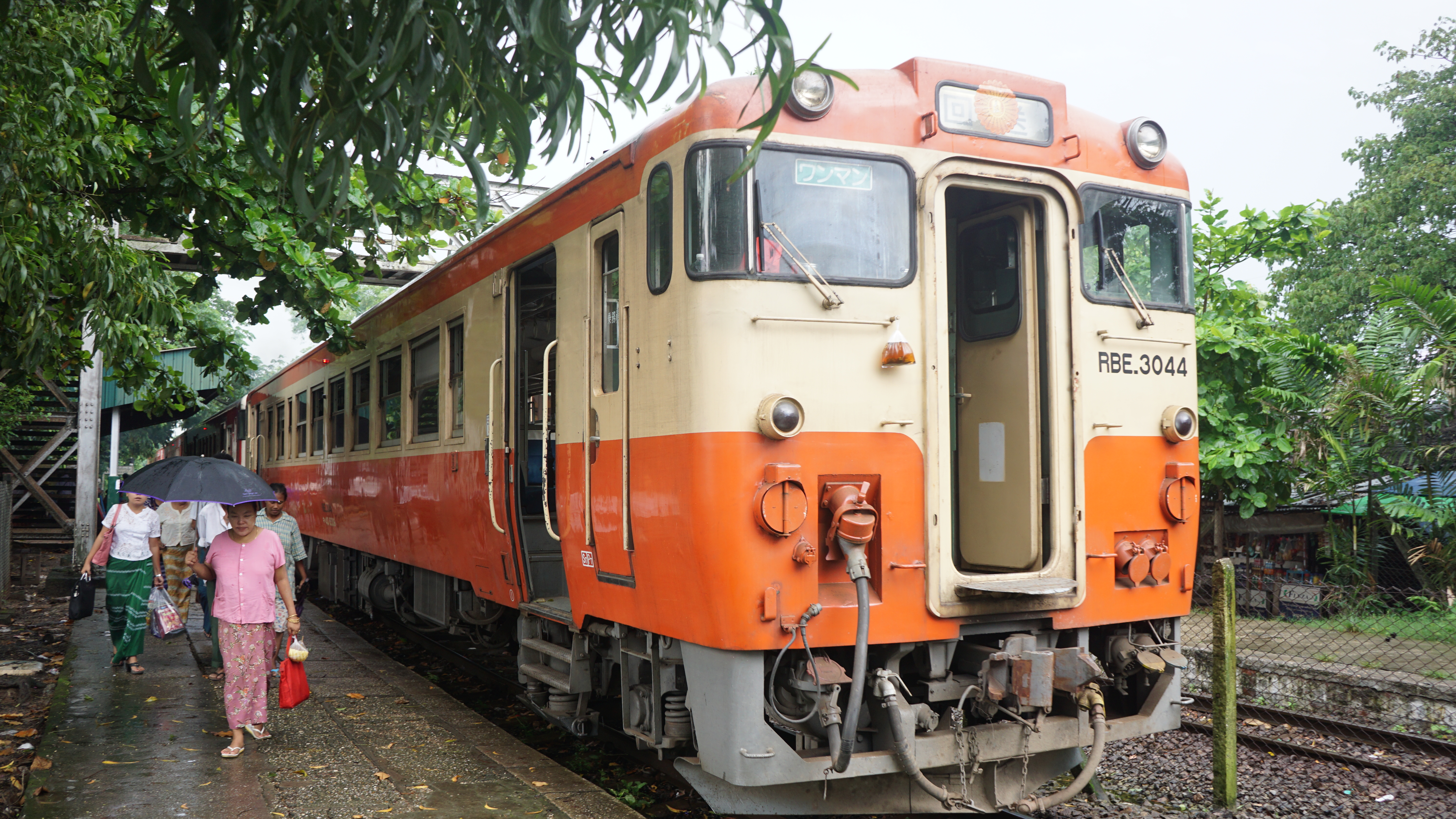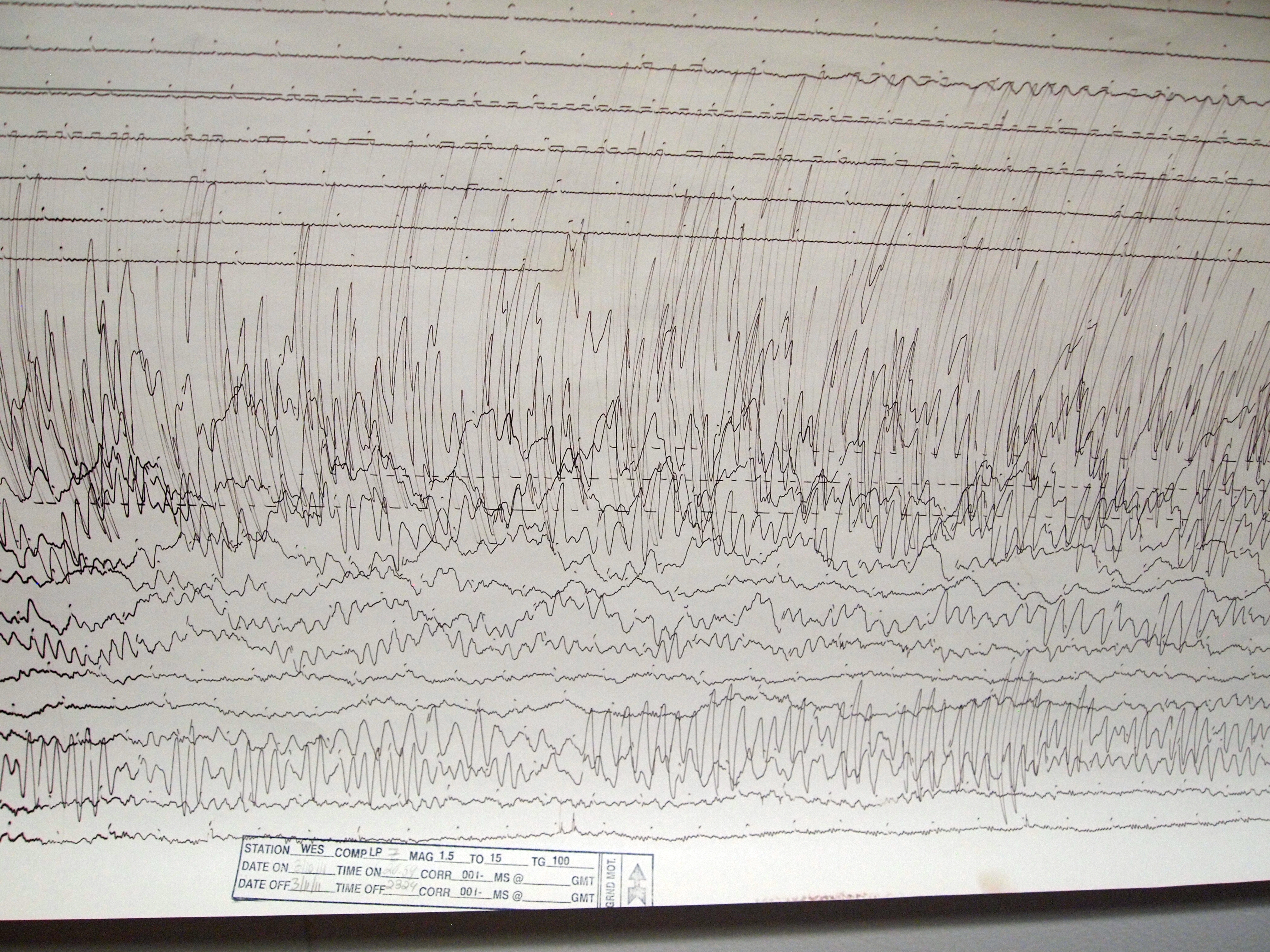|
Onagawa Station
is a railway station in the town of Onagawa, Miyagi Prefecture, Japan, operated by East Japan Railway Company (JR East). Lines Onagawa Station is a terminal station on the Ishinomaki Line, located 44.9 kilometers from the opposing terminus of the line at Kogota Station. Station layout The station has one bay platform, serving a single track, connected to the station building by a footbridge. History Onagawa Station opened on October 7, 1939. The station was absorbed into the JR East network upon the privatization of JNR on April 1, 1987. Operations were suspended after the tsunami on March 11, 2011 which destroyed the station building and nearby railway tracks. Just over four years later, on March 21, 2015, the reconstructed Onagawa Station reopened marking the restoration of the entire Ishinomaki Line. The new station building features an integrated community center and public bathing facility on the upper floors. The building was designed by Pritzker Architecture Prize ... [...More Info...] [...Related Items...] OR: [Wikipedia] [Google] [Baidu] |
Onagawa, Miyagi
is a town located in Miyagi Prefecture, Japan. , the town had an estimated population of 6,319, and a population density of 97 persons per km2 in 3,110 households. The total area of the town is . Geography Onagawa is located on the rugged Sanriku Coast of north-central Miyagi Prefecture, with the Kitakami Mountains to the west and the city of Ishinomaki to the east, south and north. Much of the town is within the borders of the Sanriku Fukkō National Park. Onagawa is a natural deep water port, located at the intersection of two major ocean currents and noted for its commercial fishing industry. Located nearby on the southern side of Onagawa Bay is the Onagawa Nuclear Power Plant. Neighboring municipalities Miyagi Prefecture *Ishinomaki Climate Onagawa has a humid climate (Köppen climate classification ''Cfa'') characterized by mild summers and cold winters with heavy snowfall. The average annual temperature in Onagawa is 11.1 °C. The average annual rainfall is 1213&nb ... [...More Info...] [...Related Items...] OR: [Wikipedia] [Google] [Baidu] |
Pritzker Architecture Prize
The Pritzker Architecture Prize is an international architecture award presented annually "to honor a living architect or architects whose built work demonstrates a combination of those qualities of talent, vision and commitment, which has produced consistent and significant contributions to humanity and the built environment through the art of architecture.” Founded in 1979 by Jay Pritzker, Jay A. Pritzker and his wife Cindy, the award is funded by the Pritzker family and sponsored by the Hyatt Foundation. It is considered to be one of the world's premier architecture prizes, and is often referred to as the Nobel Prize of architecture. The Pritzker Architecture Prize is said to be awarded "irrespective of nationality, race, creed, or ideology". The recipients receive US$100,000, a citation certificate, and, since 1987, a bronze medallion. The designs on the medal are inspired by the work of architect Louis Sullivan, while the Latin inspired inscription on the reverse of the me ... [...More Info...] [...Related Items...] OR: [Wikipedia] [Google] [Baidu] |
Railway Stations In Japan Opened In 1939
Rail transport (also known as train transport) is a means of transport that transfers passengers and goods on wheeled vehicles running on rails, which are incorporated in tracks. In contrast to road transport, where the vehicles run on a prepared flat surface, rail vehicles (rolling stock) are directionally guided by the tracks on which they run. Tracks usually consist of steel rails, installed on sleepers (ties) set in ballast, on which the rolling stock, usually fitted with metal wheels, moves. Other variations are also possible, such as "slab track", in which the rails are fastened to a concrete foundation resting on a prepared subsurface. Rolling stock in a rail transport system generally encounters lower frictional resistance than rubber-tyred road vehicles, so passenger and freight cars (carriages and wagons) can be coupled into longer trains. The operation is carried out by a railway company, providing transport between train stations or freight customer faciliti ... [...More Info...] [...Related Items...] OR: [Wikipedia] [Google] [Baidu] |
Railway Stations In Miyagi Prefecture
Rail transport (also known as train transport) is a means of transport that transfers passengers and goods on wheeled vehicles running on rails, which are incorporated in tracks. In contrast to road transport, where the vehicles run on a prepared flat surface, rail vehicles (rolling stock) are directionally guided by the tracks on which they run. Tracks usually consist of steel rails, installed on sleepers (ties) set in ballast, on which the rolling stock, usually fitted with metal wheels, moves. Other variations are also possible, such as "slab track", in which the rails are fastened to a concrete foundation resting on a prepared subsurface. Rolling stock in a rail transport system generally encounters lower frictional resistance than rubber-tyred road vehicles, so passenger and freight cars (carriages and wagons) can be coupled into longer trains. The operation is carried out by a railway company, providing transport between train stations or freight customer faciliti ... [...More Info...] [...Related Items...] OR: [Wikipedia] [Google] [Baidu] |
List Of Railway Stations In Japan ...
The links below contain all of the 8579 railway stations in Japan. External links {{Portal bar, Japan, Trains * Railway stations Japan Japan ( ja, 日本, or , and formally , ''Nihonkoku'') is an island country in East Asia. It is situated in the northwest Pacific Ocean, and is bordered on the west by the Sea of Japan, while extending from the Sea of Okhotsk in the north ... [...More Info...] [...Related Items...] OR: [Wikipedia] [Google] [Baidu] |
Japan Railfan Magazine
is a Japanese-language monthly magazine for railfans covering the mainly Japanese railways published by Koyusha. It has been published in Japan since 1961. Issues go on sale on the 21st of each month, two months before the cover month (e.g. the March issue is on sale on the 21st of January). Each copy sells for between ¥1,100 and ¥1,200 depending on the number of pages. The magazine reports on railway prototypes, complete with technical plans, photos, maps, graphs, and tables. See also * List of railroad-related periodicals A ''list'' is any set of items in a row. List or lists may also refer to: People * List (surname) Organizations * List College, an undergraduate division of the Jewish Theological Seminary of America * SC Germania List, German rugby unio ... External links * 1961 establishments in Japan Magazines published in Japan Monthly magazines published in Japan Magazines established in 1961 Railway culture in Japan Rail transport magazines ... [...More Info...] [...Related Items...] OR: [Wikipedia] [Google] [Baidu] |
Onsen
In Japan, are the country's hot springs and the bathing facilities and traditional inns around them. As a volcanically active country, Japan has many onsens scattered throughout all of its major islands. There are approximately 25,000 hot spring sources throughout Japan that provide hot mineral water to about 3,000 genuine onsen establishments. Onsens come in many types and shapes, including and . Baths may be either publicly run by a municipality or privately, often as part of a hotel, ''ryokan'', or . The presence of an onsen is often indicated on signs and maps by the symbol ♨ or the kanji (''yu'', meaning "hot water"). Sometimes the simpler hiragana character ゆ (''yu''), understandable to younger children, is used. Traditionally, onsens were located outdoors, although many inns have now built indoor bathing facilities as well. Nowadays, as most households have their own bath, the number of traditional public baths has decreased, but the number of sightseeing ho ... [...More Info...] [...Related Items...] OR: [Wikipedia] [Google] [Baidu] |
KiHa 40 Series
The is a diesel multiple unit (DMU) train type introduced by Japanese National Railways (JNR) in 1977 and operated by all Japan Railways Group companies on suburban and rural services in Japan. Since 2017, the train type has seen use by other private railway companies in Japan, following the removal of services by Japan Railways groups. Additionally, it has also seen use in overseas operations in Myanmar since 2011. Overview The KiHa 40 series diesel multiple unit was introduced in 1977 by JNR to replace ageing KiHa 10 series DMUs on suburban and rural services nationwide. A total of 888 vehicles were built between 1977 and 1982, broadly divided into three main types: KiHa 40, KiHa 47, and KiHa 48. These were subdivided as shown below, with further variants and modifications made later in their lives by the various JR Group companies. "Cold" regions refers to the Tohoku and Chubu regions. JR Hokkaido Following the privatization and splitting of JNR in April 1987, JR Hokk ... [...More Info...] [...Related Items...] OR: [Wikipedia] [Google] [Baidu] |
Shigeru Ban
Biography , The Hyatt Foundation, retrieved 26 March 2014 is a Japanese architect, known for his innovative work with paper, particularly recycled Corrugated fiberboard, cardboard tubes used to quickly and efficiently house disaster victims. Many of his notable designs are structures which are temporary, Prefabricated building, prefabricated, or incorporate inexpensive and unconventional materials in innovative ways. He was profiled by ''Time (magazine), Time'' magazine in their projection of 21st-century innovators in the field of architecture and design. In 2014, Ban was named the 37th recipient of the Pritzker Architecture Prize, the most prestigious prize in modern architecture. The Pritzker Jury cited Ban for his innovative use of material and his dedication to hu ... [...More Info...] [...Related Items...] OR: [Wikipedia] [Google] [Baidu] |
2011 Tōhoku Earthquake And Tsunami
The occurred at 14:46 JST (05:46 UTC) on 11 March. The magnitude 9.0–9.1 (M) undersea megathrust earthquake had an epicenter in the Pacific Ocean, east of the Oshika Peninsula of the Tōhoku region, and lasted approximately six minutes, causing a tsunami. It is sometimes known in Japan as the , among other names. The disaster is often referred to in both Japanese and English as simply 3.11 (read in Japanese). It was the most powerful earthquake ever recorded in Japan, and the fourth most powerful earthquake in the world since modern record-keeping began in 1900. The earthquake triggered powerful tsunami waves that may have reached heights of up to in Miyako in Tōhoku's Iwate Prefecture,Yomiuri Shimbun evening edition 2-11-04-15 page 15, nearby Aneyoshi fishery port (姉吉漁港)(Google map E39 31 57.8, N 142 3 7.6) 2011-04-15大震災の津波、宮古で38.9 m…明治三陸上回るby okayasu Akio (岡安 章夫) and which, in the Sendai area, traveled at a ... [...More Info...] [...Related Items...] OR: [Wikipedia] [Google] [Baidu] |
Oshika District, Miyagi
Map showing original extent of Oshika District in Miyagi Prefecturecolored area=original extent in Meiji period; green=present area is a rural district located in Miyagi Prefecture, in the Tōhoku region of northern Japan. Most of the city of Ishinomaki was formerly within the district. From 2006, the district has consisted only of the town of Onagawa. As of 2021, the district has an estimated population of 5,636 and a population density of 86.2 persons per km2. The total area was 65.35 km2. History During the Edo period under the Tokugawa shogunate, the district was within Mutsu Province and was under the control of the Date clan of Sendai Domain. In 1869, following the Meiji restoration The , referred to at the time as the , and also known as the Meiji Renovation, Revolution, Regeneration, Reform, or Renewal, was a political event that restored practical imperial rule to Japan in 1868 under Emperor Meiji. Although there were ..., Mutsu Province was divided, with th ... [...More Info...] [...Related Items...] OR: [Wikipedia] [Google] [Baidu] |






